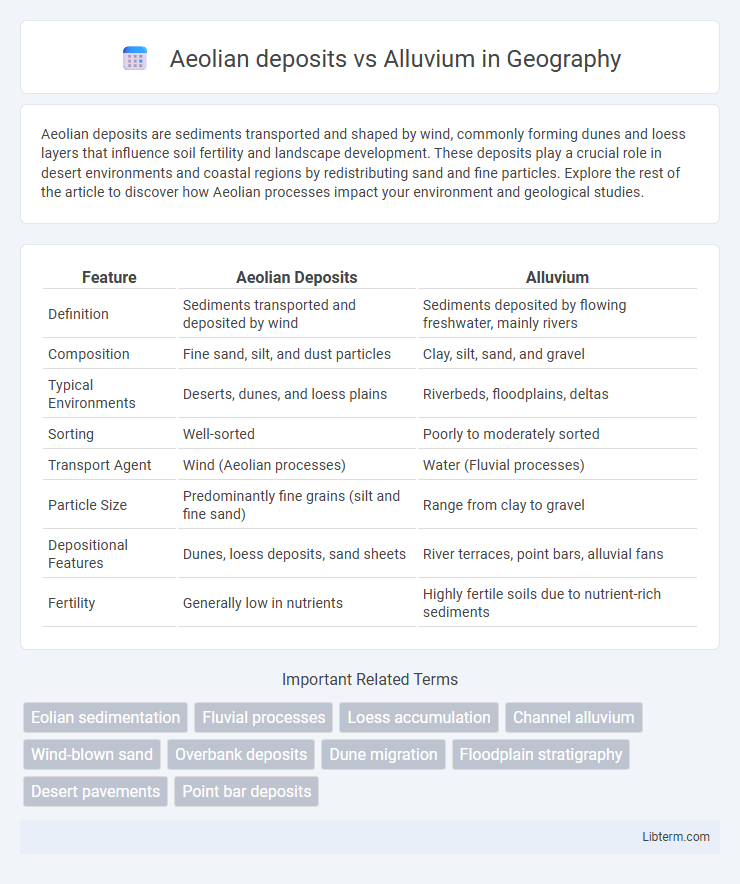Aeolian deposits are sediments transported and shaped by wind, commonly forming dunes and loess layers that influence soil fertility and landscape development. These deposits play a crucial role in desert environments and coastal regions by redistributing sand and fine particles. Explore the rest of the article to discover how Aeolian processes impact your environment and geological studies.
Table of Comparison
| Feature | Aeolian Deposits | Alluvium |
|---|---|---|
| Definition | Sediments transported and deposited by wind | Sediments deposited by flowing freshwater, mainly rivers |
| Composition | Fine sand, silt, and dust particles | Clay, silt, sand, and gravel |
| Typical Environments | Deserts, dunes, and loess plains | Riverbeds, floodplains, deltas |
| Sorting | Well-sorted | Poorly to moderately sorted |
| Transport Agent | Wind (Aeolian processes) | Water (Fluvial processes) |
| Particle Size | Predominantly fine grains (silt and fine sand) | Range from clay to gravel |
| Depositional Features | Dunes, loess deposits, sand sheets | River terraces, point bars, alluvial fans |
| Fertility | Generally low in nutrients | Highly fertile soils due to nutrient-rich sediments |
Introduction to Aeolian Deposits and Alluvium
Aeolian deposits consist of fine-grained sediments such as sand and silt transported and deposited by wind, commonly forming dunes and loess plains in arid and semi-arid regions. Alluvium refers to sediments like sand, silt, clay, and gravel deposited by flowing water, typically found in riverbeds, floodplains, and deltas. The distinction lies in their transportation medium: aeolian deposits result from wind action, whereas alluvium originates from fluvial processes.
Defining Aeolian Deposits
Aeolian deposits consist of sediment transported and deposited by wind, primarily composed of fine sand, silt, and clay particles forming features like dunes and loess. These deposits are distinguished from alluvium, which originates from waterborne sediments found in rivers, floodplains, and deltas. Aeolian sediments typically exhibit well-sorted and rounded grains due to prolonged wind transport, whereas alluvium is more variable in texture and sorting.
Defining Alluvium
Alluvium refers to loose, unconsolidated sediments like sand, silt, clay, and gravel deposited by flowing water in riverbeds, floodplains, and deltas. Aeolian deposits consist primarily of wind-blown particles such as sand dunes and loess, differing from alluvium by their mode of transport and typical sediment structures. The defining characteristic of alluvium is its origin through fluvial processes, which contributes to fertile soil profiles commonly found in agricultural regions.
Key Differences in Formation Processes
Aeolian deposits form through wind-driven transport and accumulation of fine particles such as sand and silt, predominantly in arid or semi-arid environments, leading to dune and loess formations. Alluvium results from water-driven processes, where rivers and streams deposit sediments like sand, gravel, silt, and clay in floodplains, riverbeds, and deltas. The primary distinction lies in the transporting medium--wind for Aeolian deposits and water for alluvium--shaping their texture, sorting, and sedimentary structures.
Major Characteristics of Aeolian Deposits
Aeolian deposits are primarily characterized by fine-grained, well-sorted sand and silt particles shaped by wind action, commonly forming dunes and loess plains. These sediments exhibit features such as cross-bedding, rounded grains, and low organic content, distinguishing them from alluvium, which is deposited by water and typically contains a mix of particle sizes including coarser materials. Aeolian deposits have high porosity and permeability, influencing soil properties and groundwater movement in arid and semi-arid regions.
Major Characteristics of Alluvium
Alluvium consists of unconsolidated sediments such as sand, silt, clay, and gravel, primarily deposited by running water in riverbeds, floodplains, and deltas. These deposits are characterized by high fertility, good drainage, and stratification reflecting episodic sedimentation from varying flow regimes. Unlike aeolian deposits, alluvium exhibits well-sorted layers aligned with fluvial processes, making it significant for agriculture and groundwater recharge.
Geographical Distribution and Occurrence
Aeolian deposits predominantly occur in arid and semi-arid regions such as deserts in the Sahara, Arabian Peninsula, and Australian Outback, formed by wind-driven sediment transport and accumulation. Alluvium is commonly found in river valleys, floodplains, and deltas worldwide, including the Indo-Gangetic Plain, Mississippi River Basin, and Nile Delta, where water flow deposits sediments. The geographical distribution of aeolian deposits is characterized by dry landscapes with sparse vegetation, whereas alluvium is closely associated with active fluvial systems and wetter climatic zones.
Sediment Composition and Grain Size
Aeolian deposits typically consist of well-sorted, fine to medium sand-sized particles dominated by quartz due to wind transport, resulting in rounded grains with uniform mineralogy. Alluvium, in contrast, contains a more heterogeneous mixture of gravel, sand, silt, and clay derived from various rock types, reflecting the diverse source materials transported by river systems. The grain size in alluvium is more variable and poorly sorted compared to the consistently finer and better-sorted sediments of aeolian deposits.
Significance in Landscape Evolution
Aeolian deposits, formed by wind-driven sedimentation such as loess and dune sands, sculpt arid and semi-arid landscapes by creating unique landforms and influencing soil development. Alluvium, consisting of water-transported sediments deposited in river channels, floodplains, and deltas, plays a critical role in shaping fertile valleys and enabling dynamic fluvial processes essential for habitat diversity. These two sediment types collectively drive landscape evolution by modulating geomorphological features, sediment distribution, and ecosystem productivity across varied environmental settings.
Practical Applications and Environmental Impact
Aeolian deposits, composed mainly of fine sand and silt, are crucial for understanding wind-driven soil erosion and are often used in land reclamation projects due to their well-sorted texture that enhances soil permeability. Alluvium, consisting of mixed sediments like clay, sand, and gravel deposited by flowing water, supports fertile agricultural lands and groundwater recharge but is susceptible to contamination from industrial runoff. Both play significant roles in environmental management, with Aeolian deposits influencing desertification control strategies and alluvium affecting floodplain restoration and sediment transport modeling.
Aeolian deposits Infographic

 libterm.com
libterm.com